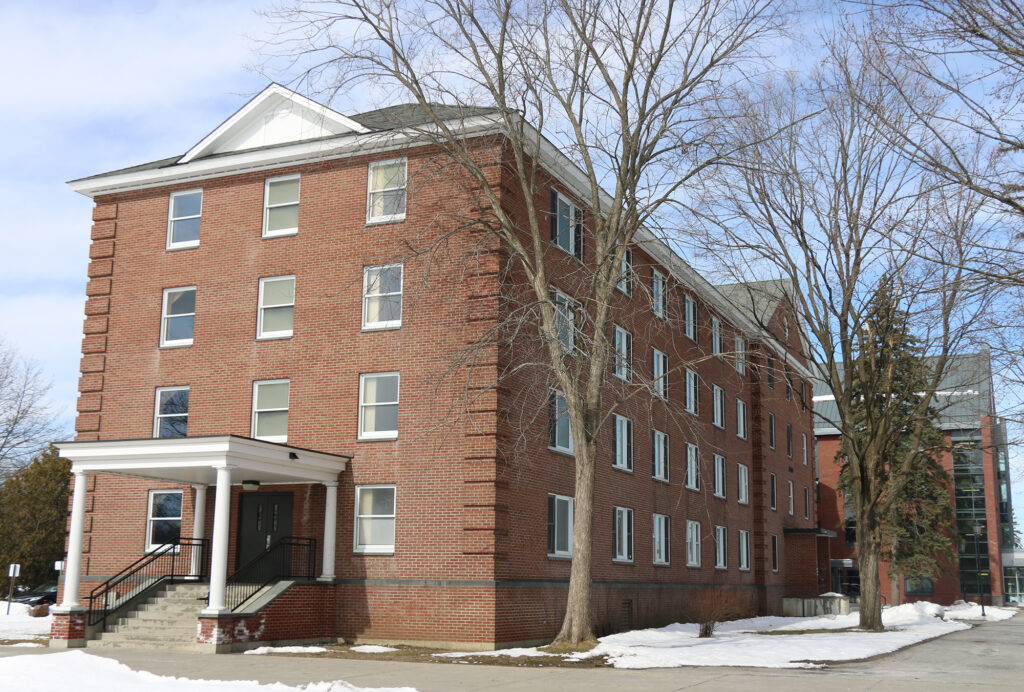
By: Catherine O’Donnell | Staff Writer | codonnell3@mail.smcvt.edu
On Thursday, Feb. 9, it was announced in an email that Lyons Hall, Hodson Hall, and Boutin Commons Townhouses (the 100s) will not be housing students in the 2023-2024 academic year. When students received this news, some wondered how on-campus life will change and what this decision means for the future of Saint Michael’s.
Dawn Ellinwood, vice president of Student Affairs and dean of students, said that the College cabinet had been discussing the possibility of a housing consolidation since May of 2022, when they received low enrollment numbers for the class of 2026. The cabinet is made up of the direct reports to the president, and includes the vice presidents of Academic Affairs, Finance, Enrollment and Marketing and more. In recent months, they have been observing the trend of students living on campus, and the high number of empty rooms. They decided it was time to formulate a new housing plan.
“Looking at our enrollment numbers, and how students are spread out right now, it makes no sense to keep the same footprint if we can consolidate and save money,” Ellinwood said. She also noted the cabinet’s focus on the environmental benefits. They wanted the campus to be as energy efficient as possible, and Ellinwood said it seemed counterintuitive to keep all buildings open when they are not full.
The Boutin Commons Townhouses have been out of undergraduate lottery for multiple years, so this change will not be as impactful as the closure of Lyons and Hodson. There have only been a handful of undergraduate students living there recently. The 100s will continue to house graduate students, Fulbright scholars, and staff members. Lyons and Hodson will be completely empty.
With the elimination of residence halls will come a redistribution of the students occupying the remaining buildings. Cronogue Hall, which previously housed juniors and seniors only, will now be open to sophomores as well. Alumni Hall, soon to be the only occupied dorm-style building on campus, will house first-years only. The 200s and 300s Townhouses will remain exclusive to juniors and seniors.
First-years can live in Canterbury Hall suites if they want to live in themed housing, which includes GREAT (alcohol and drug free), honors and LGBTQ+ housing. In recent years, some first-years have been living in the suites. However, next year there will be space specifically dedicated to the incoming class.
Lyons and Hodson will begin to serve other purposes, but currently no decisions have been made. Ryan Hall, another dorm building that has been offline since 2020, is used for visitor programs. Visitors from Africa are currently staying in Ryan as part of an exchange program for leadership training in the U.S.
Both Ellinwood and Rob Robinson, vice president of finance, said that the buildings will be rented out to other organizations. Robinson believes they will remain residence halls. “With the housing crunch that is all around us in Chittenden County, I think housing is the thing that is needed, and a need we can fill,” Robinson said.
“Whatever does come to campus will be part of our community and will be mission driven,” Ellinwood said. “The income that would come from renting those spaces will be fed right into the experience of our SMC students.”
When students heard about the changes, rumors began running rampant about the future of the school. Norah White ‘25 said that talk of St. Michael’s closing down has been prevalent among her peers. “I’ve heard from multiple students on campus that in the next few years UVM will probably end up buying us out,” White said. Ellinwood shut down the rumors, but understands that a major change is grounds for concern.
“St. Michaels is not closing anytime soon,”
“St. Michaels is not closing anytime soon,” Ellinwood said. “We have a $93 million endowment. We have the ability to make decisions, and turn and pivot because we have finances…So that’s not on the table at all…but I can understand how people are getting nervous.”
Next year, the residential fee for living in a suite will be $17,670 per year. The fee for a traditional dorm-style living will be $16,495 per year. Cheaper housing will be harder to come by when there are fewer dorm-style residence halls available.
Ellinwood emphasized that deciding which residence halls to close was about the trends among students. Newer, typically sought after residence halls were prioritized. She said the increase in cost was not a factor.
While some students may desire suite-style living, other students are concerned about losing the benefit of a dorm. Lyons RAs Megan Gallo ‘24 and Willow Morin ‘25 have both witnessed and personally experienced the benefits of living with a roommate and sharing a bathroom with floormates. “It’s a really important experience for growing up,” Gallo said. “You learn how to live in a communal space…you just don’t get that in a suite.”
Gallo and Morin said that RAs were frustrated with being in the dark about the changes. They were not given a heads up before the announcement, and were given no additional information after the fact. Like other students, the rumor mill has been their only source of information. Furthermore, the news was released the day after RA applications were due. Many students applied with the expectations of being an RA in Lyons or Hodson.
Gallo and Morin said that RA positions will not be eliminated, they will just be redistributed. There will be the same amount of RAs, just more per building.
Brian Lee, the director of housing operations, provided records of occupancy of on-campus housing in the last five years. This past semester, 1143 students lived on campus. This number has steadily dropped since 2018, when 1613 students filled the residence halls.
The permanence of the upcoming housing arrangements is unclear at the moment, even among the administration. Student enrollment makes this a difficult situation to predict. Both Ellinwood and Lee said that they hope for the future, but are unable to make conclusions. Though enrollment has been declining, it is possible that this trend will change with time. The goal is to eventually grow back into the buildings that are closing.
“We hope that it is only temporary, and that when enrollment numbers increase again, the need to house students in those areas will return,” Lee said in an email.

